Maa ki Dal recipe with step by step photos. At home all my folks are fond of black lentils (black gram or kali urad dal) or Punjabi kali dal recipe. This delicious and creamy Punjabi lentil dish is made with whole black gram (sabut urad dal), onions, tomatoes and the usual Indian spices. Comforting, filling and satisfying meal when served with phulka, roti, paratha or naan.
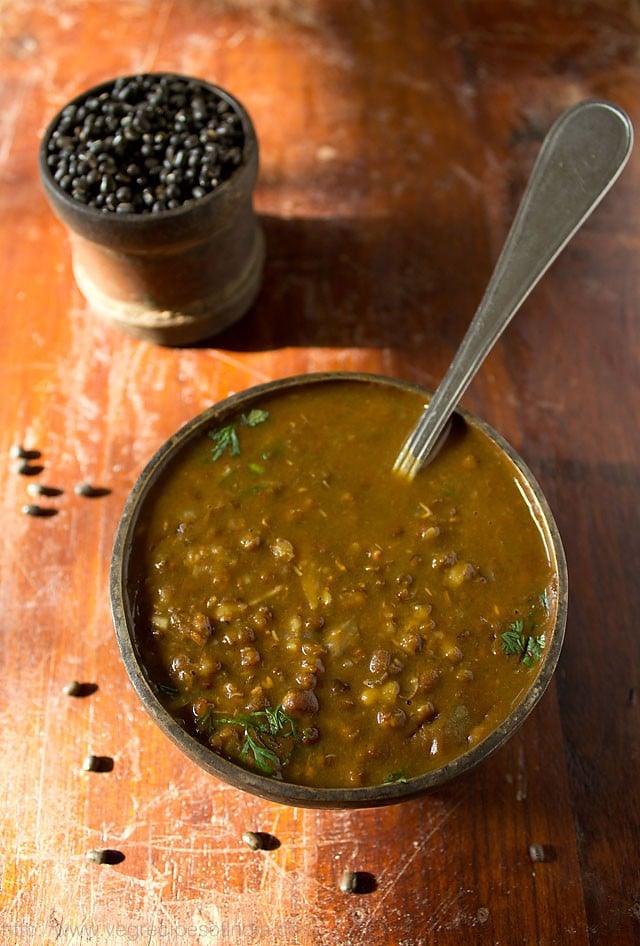
In Punjabi these lentils are called Mah di dal or maa di dal or manh di daal. At home everybody called whole black lentils as maa di dal.
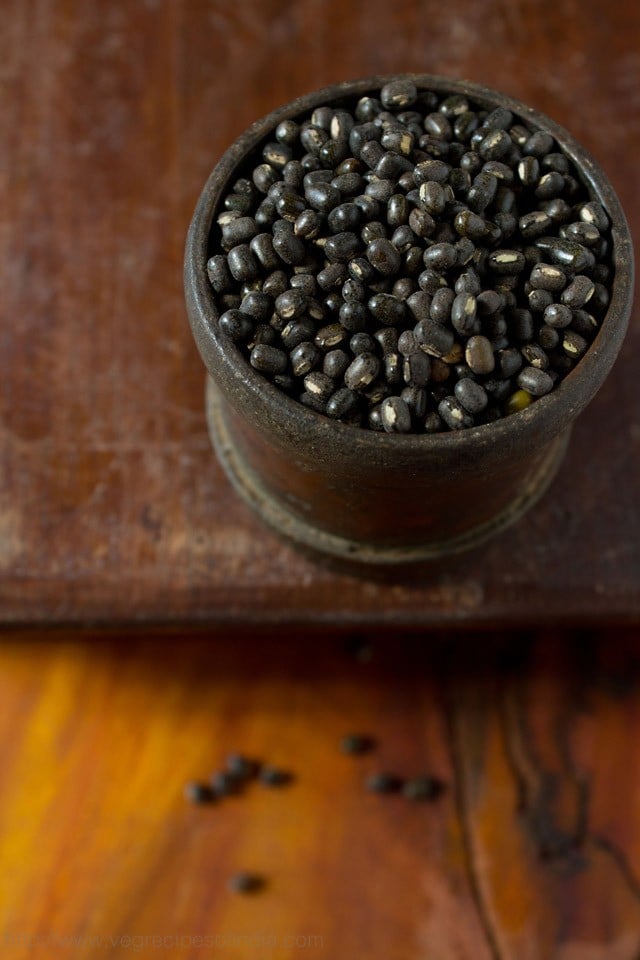
Maa ki dal is also known as kali dal, but it is not dal makhani. So let me tell you what is the difference between maa ki dal and dal makhani.
Maa ki dal or kali dal is made from whole black grams (black dal or kali urad dal or sabut urad dal) only. There are many ways of making this black gram dal recipe. It can be spicy or less spiced as well. It is also not a very rich and heavy dish as no extra cream, butter is added to it.
Whereas Dal Makhani is made from a mix of whole black grams, kidney beans (rajma), and some times chana dal. It is a rich dish as it is made with butter, cream and sometimes yogurt too. It is a makhani dish.
Makhani means buttery. The word makhani is derived from the Punjabi word Makhan which means Butter. So dal makhani is a buttery creamy rich dish.
So kali dal or maa ki dal is not dal makhani. They are two different dishes. Just to let you know there is another Punjabi dish called maa chole di dal – this is made from black lentils and chana dal. It is a staple at my home.
Usually, at home I cook Dal fry, Dal tadka, various sabjis, pulao, khichdi, idli, dosa, sambar. For me these are simple, comforting foods.
This recipe of kali dal is a light recipe with a spicy touch to it. I have made this with sunflower oil and no butter or ghee. For a more richer version you can make it with butter or ghee. You could also add some cream in the end if you prefer.
The main ingredients of this star dish besides whole black gram are onions, green chilies, tomato puree and crushed ginger-garlic sauteed with Indian spices.
Generally maa ki daal is cooked and simmered in a pot. In a modern day life we don’t have the luxury and leisure to let our dals cook in pots. The black lentils take a lot of time to cook in a pot.
I have cooked the dal in a stovetop pressure cooker. It is a quick cooking method and what might take hours, just gets done in 30 to 40 minutes. If you have Instant pot then you can also make this dish in it adding water as needed.
Also remember to use fresh lentils as they cook faster compared to aged lentils. I also recommend to soak the lentils for some minutes prior to cooking. Soaking lentils reduces the cooking time and also helps in getting rid of the phytic acid in them.
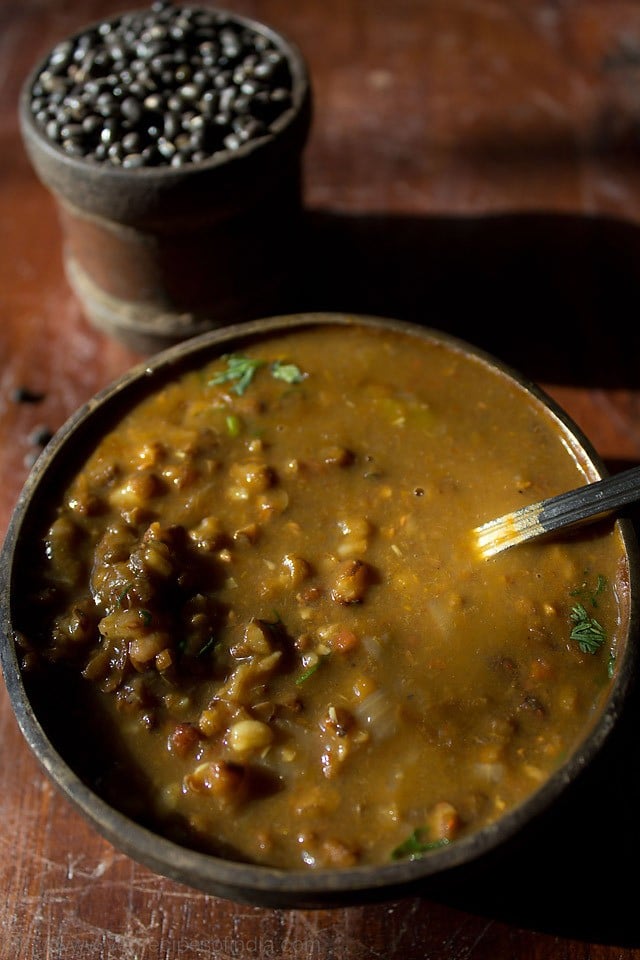
Maa ki dal goes very well with roti, naan and even rice. So if you are fond of Punjabi dishes, then do try this awesome kali dal recipe. You and your family are going to love it. You don’t have to trust me. You have to make this at home and relish the maa di dal.
How to make Kali Dal or Maa ki dal
1: Pick the sabut urad dal (whole black gram with husks), rinse in water for 2 to 3 times. Later drain the water and soak the lentils in enough water in a bowl for about 30 to 40 minutes.
The soaking time can vary depending on the quality and age of the lentils. Sometimes even after soaking for an hour or so, these aged lentils take a lot of time to cook.
So you can soak sabut urad dal overnight or for some 4 to 5 hours. So if using old lentils or lentils near expiry date, soak them overnight. Later, drain the soaked dal.
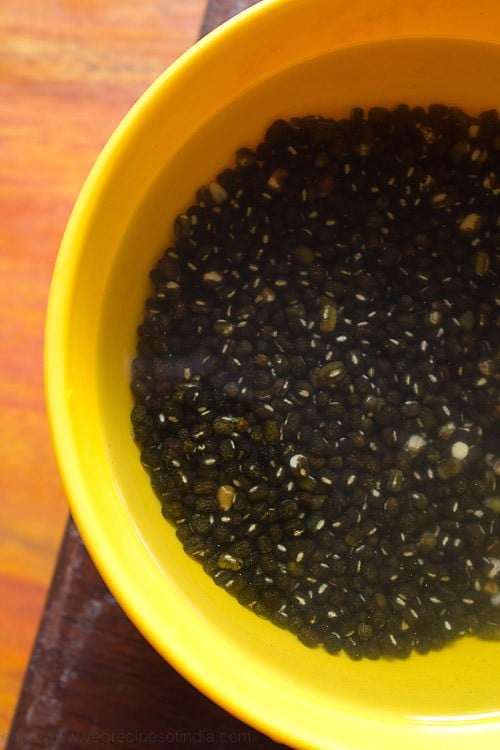
2: Heat 2 tablespoons of ghee or oil in a 3 litre stovetop pressure cooker. Instead of ghee you can also use butter.
Add ½ teaspoon cumin seeds. Keep the heat to low. When they sizzle and crackle, add 1 medium-sized chopped onion (about ⅓ cup chopped onions).
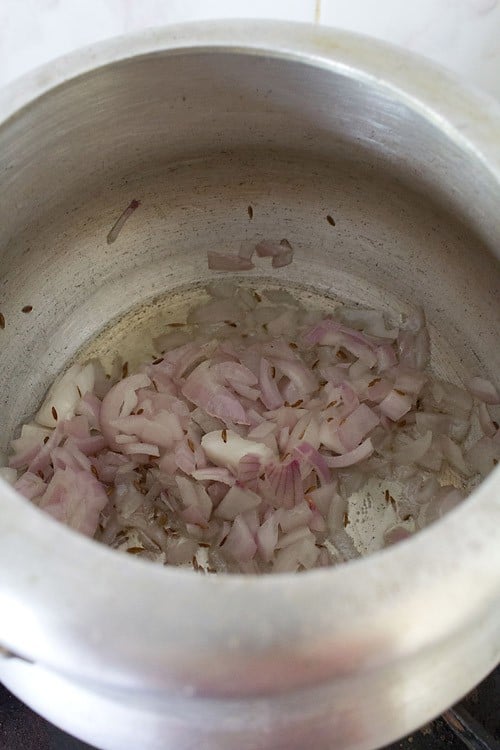
3: Stirring at regular intervals, fry the onions till light brown or golden on low to medium-low heat.
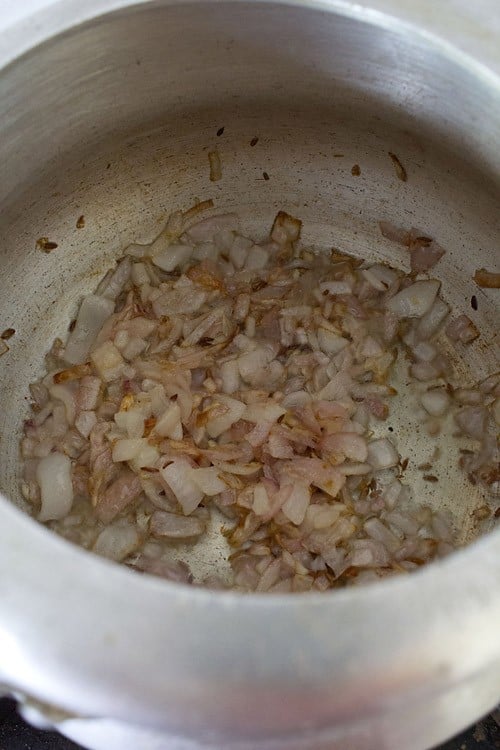
4: Now add the pureed tomatoes. Stir and mix well. I have pureed or blended 2 medium sized tomatoes in a blender and this yields about 1 cup of tomato puree.
You can easily swap fresh tomato puree with canned tomato puree.
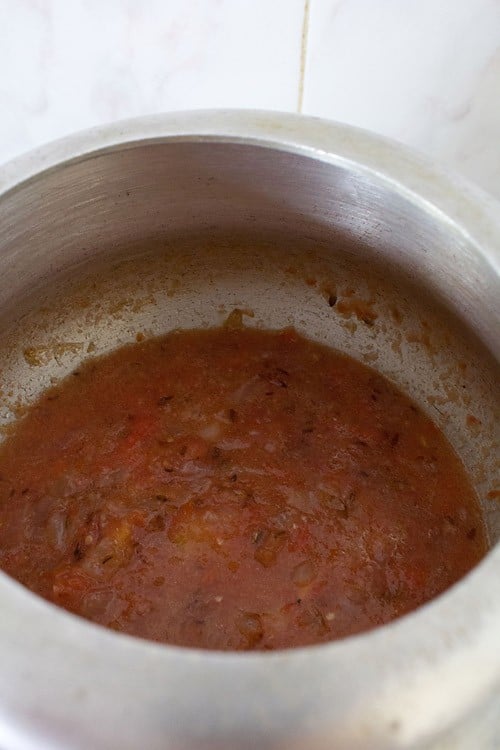
5: Add the crushed ginger and garlic – about 3 to 4 small to medium-garlic cloves and 1 inch ginger crushed in a mortar-pestle. Or add 2 teaspoons ginger-garlic paste instead.
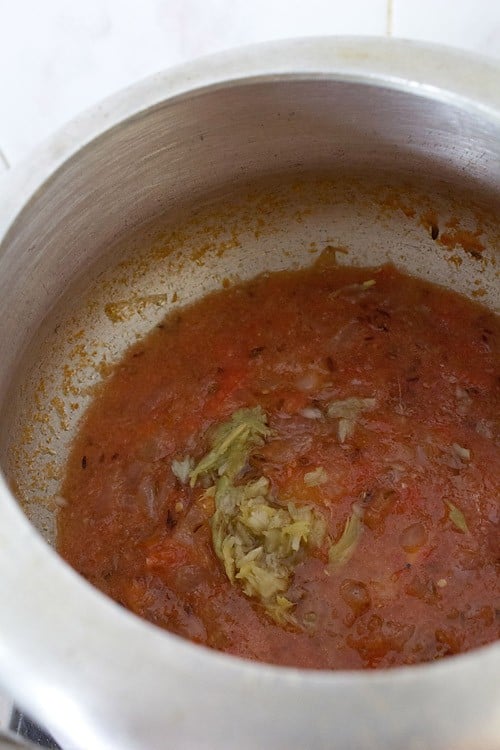
6: Add all the dry spice powders. In this below photo I have added the following ground spices one by one:
- 1 teaspoon coriander powder
- ½ teaspoon turmeric powder
- ½ teaspoon red chili powder
- ¼ teaspoon garam masala powder
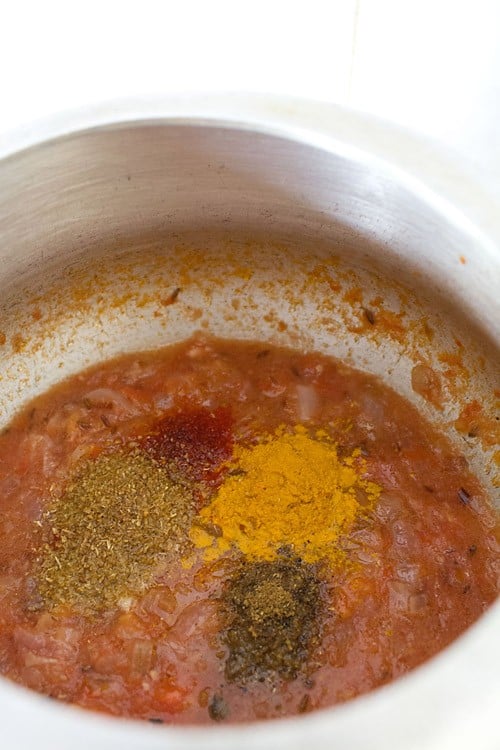
7: Stir the spice powders and mix well.
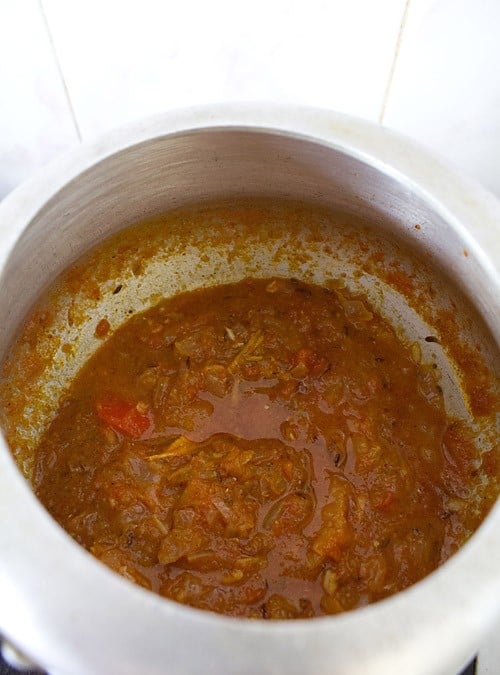
8: Then add 1 finely chopped green chili or ½ to 1 teaspoon chopped green chillies.
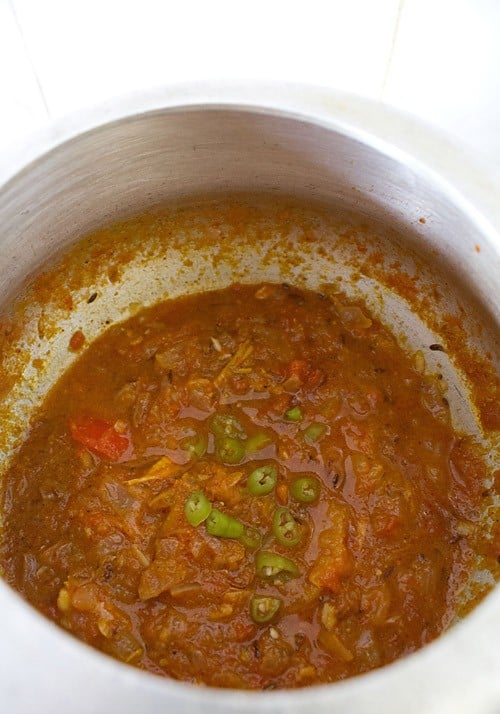
9: Sauté the masala stirring often on a low to medium-low heat till the oil starts to leave or separate at the sides. Take care the masala does not burn while sautéing.
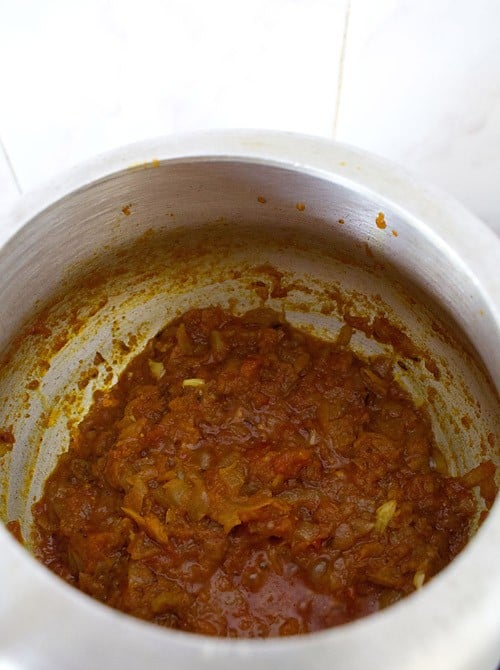
10: Add the drained and soaked sabut urad dal (black gram).
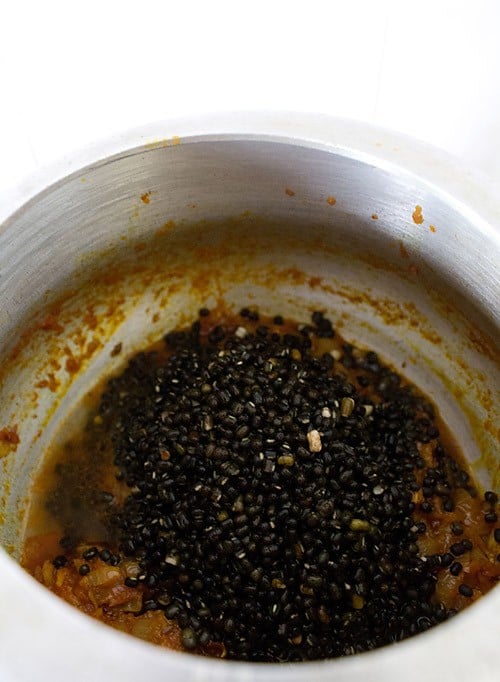
11: Add 3 to 3.5 cups of water and salt as required. Stir and mix well.
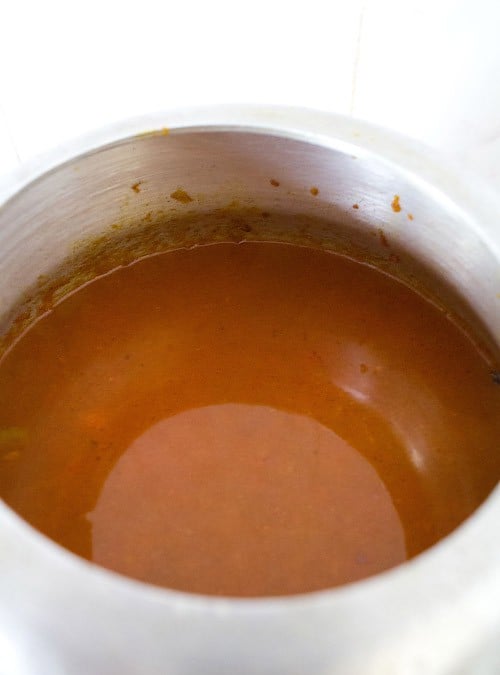
Cover the pressure cooker with its lid and pressure cook the dal for some 20 to 25 minutes on medium to medium-high heat till the lentils are soft, tender and thoroughly cooked. When the pressure falls down naturally in the cooker then only open the lid.
Simmer the lentils on low to medium low heat stirring often. Mash some lentils with the spoon whiles the lentils are simmering. This helps to thicken the consistency of the dal.
Cook and simmer till you get a creamy consistency. I kept the maa ki dal a little thin as we prefer thin dals in summer. You can keep the consistency as per your preference.
Garnish it with coriander leaves and serve maa ki dal hot or warm with naan, kulcha, rotis or plain paratha. You can also have it with steamed basmati rice.
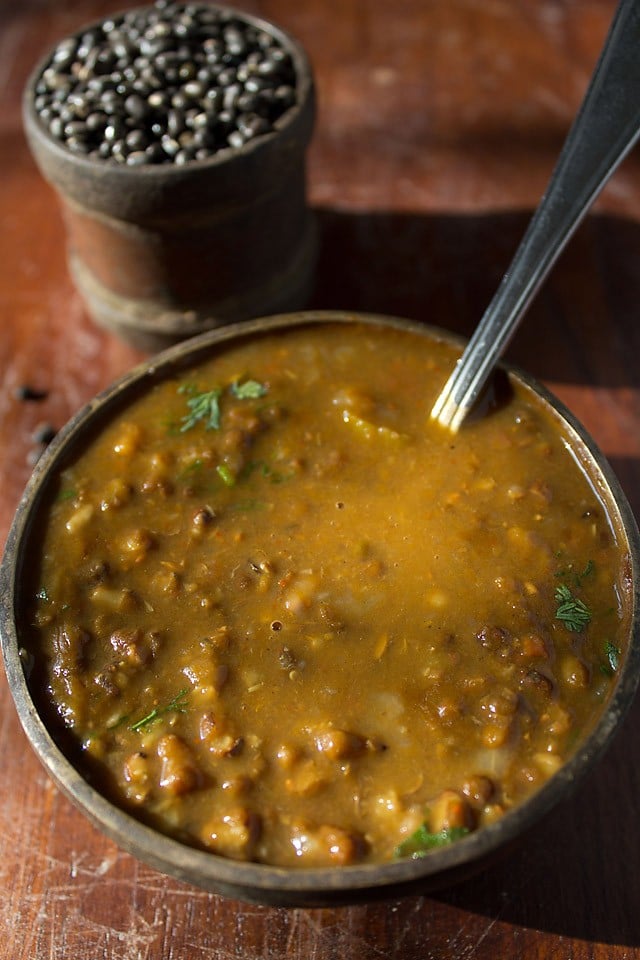
Please be sure to rate the recipe in the recipe card or leave a comment below if you have made it. For more vegetarian inspirations, Sign Up for my emails or follow me on Instagram, Youtube, Facebook, Pinterest or Twitter.
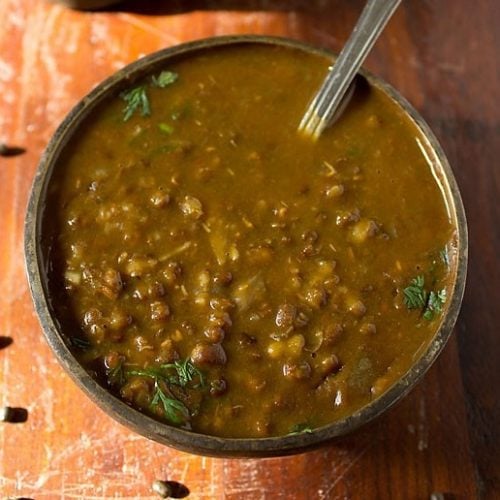
Kali Dal | Punjabi Black Dal (Maa Ki Dal)
Ingredients
- 1 cup whole black lentils (sabut urad dal or black gram)
- 1 medium onion – chopped or ⅓ cup chopped onions
- 2 medium tomatoes pureed – yields approx 1 cup tomato puree
- 2 to 3 garlic cloves small to medium – crushed in a mortar-pestle
- 1 inch ginger – crushed in a mortar-pestle
- 1 green chili – finely chopped or ½ to 1 teaspoon chopped green chillies
- 1 teaspoon Coriander Powder (ground coriander)
- ½ teaspoon cumin seeds
- ½ teaspoon turmeric powder (ground turmeric)
- ½ teaspoon red chili powder (or cayenne pepper or paprika)
- ¼ teaspoon Garam Masala
- 2 tablespoons oil or ghee or butter
- 3 to 3.5 cups water or add as required
- salt as required
- 1 to 2 tablespoons coriander leaves for garnishing, optional
Instructions
Soaking Lentils
- Pick the sabut urad dal and rinse in water for 2 to 3 times and soak it in water for 30 to 40 minutes. You can also soak the lentils for 4 to 5 hours or overnight, depending on the quality of dal. If the lentils are old or near expiry date, then soak overnight.
- Later drain the soaked sabut urad dal.
Making maa ki dal
- Heat ghee or oil in a 3 litre stovetop pressure cooker. Instead of ghee you can also use butter. Keep the heat to low. Add the cumin seeds. When they sizzle and crackle, then add chopped onions.
- Fry the onions stirring often till light brown or golden on low to medium-low heat.
- Add the pureed tomatoes. Stir and mix well.
- Next add the crushed ginger-garlic or ginger-garlic paste.
- Add the all the dry spice powders – coriander powder, turmeric powder, red chili powder and garam masala powder. Stir the spice powders and mix well.
- Add chopped green chilies.
- Saute the masala on a low to medium-low heat till the oil starts to leave or separate at the sides. Ensure that the masala does not burn while sauteing.
- Add the soaked sabut urad dal (black gram). Add water and salt as needed. Stir and mix well.
Cooking maa ki dal
- Cover the pressure cook for about 15 to 18 whistles or 18 to 20 minutes or till the lentils have become soft and buttery. If still they are not cooked well, then continue to pressure cook for a few more whistles.
- When the pressure falls down naturally in the cooker then only open the lid.
- If the dal looks thin, then simmer without the lid, till it reaches the desired consistency.
- Garnish with coriander leaves.
- Serve maa ki dal hot with naan, kulcha, rotis, plain paratha or plain boiled rice.
Nutrition Info (Approximate Values)
This Black Dal recipe from the blog archives first published in April 2012. It has been republished and updated on January 2022.
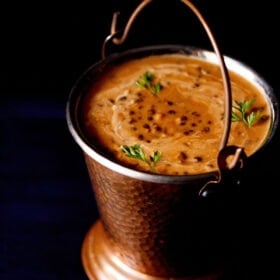
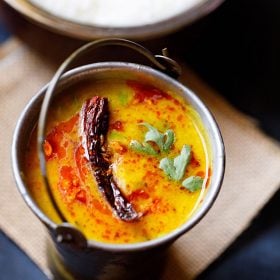
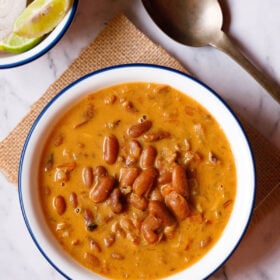
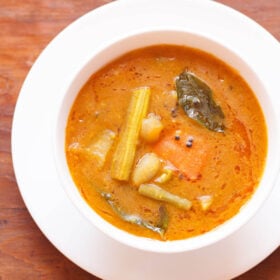








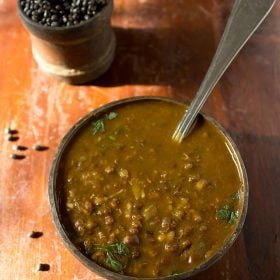
Thank you so much for gng such a fabulous recipes..
I make each n every item at my kitchen.. by referring your’s recipe. . N every1 at my home appreciate d food prepared by me.. n my in laws always live me for ds.. thank u so much.. to make me a good cook
you are always welcome 🙂 pleased to know this priti and thankyou for your kind and positive words.
P.S: and Kaali Dal here is made with Saaboot Masoor Ki Dal or Whole Masoor.
uzra, good to know this.
Hi Dassana,
Came across your site while searching for authentic recipes. Usually I don’t comment but I thought I had to when I read that even your husband and MIL did not know why Mah dee Dal is called Mah.
I am from across the border and have spent a lot of time in the Punjab on the other side but now live overseas.
The national language here is Urdu and in Urdu, Urid Ki Dal is called Maash ki Dal but the Punjabis here shortened it and spoken in the Punjabi accent it sounds like Maah Di Dal.
Hope that helps 🙂
Keep those delicious recipes coming.
Warm regards,
Uzra
Thanks Uzra for sharing this info. most of us don’t know the history. good to know this.
Hi
I love your way of explaining the recipe with pictures of each step. You explain every dish so easily.Really awesome.Thanks alot my friend.
thanks preet.
Hi dassana, thank u very much for your kind reply n detailed explanation n instructions… it will really help me a lot…Thanks again for noticing my query.. i really appreciate your help…
welcome snehal. feel free to ask any query in future also.
Hi dassana.. love this recipe…. just wanted to know… do I need to cook the tomatoes before pureed…and can u plz tell me…how do u make tomato puree always for curries n subzi…with cooked or raw tomatoes…
You can make tomato puree either with raw or blanched tomatoes. I make either depending on the time constraints. Just chop the tomatoes and add them to the blender. To make a smooth puree from raw tomatoes, you need to have a good blender. Otherwise the skin and seed particles can be seen. For blanched one, boil water. Add tomatoes and cook for 1 to 2 minutes. Then switch off and cover the pan with a lid for 20 to 30 minutes. Drain and peel the tomatoes. The peels come out easily after you blanch the tomatoes. Chop and puree them.
Thank you so much for this fantastic recepie. Tried this today, extremely simple to make and turned out really delicious.
welcome himali. glad to know that you liked the mah ki dal recipe.
Dassana,
Something is terribly wrong with how I’m understanding this recipe. I did everything exactly as you have stated, and instead of 30 mins, I soaked the dal for an hour; instead of 12-15 whistles, I gave it 25 whistles continuously, but it still came out totally uncooked and hard as ever. Then I gave it 20 more whistles, and it still was hard as new. Then I got pretty fed up, and mashed the dal slightly with a pestle, and gave it 25 more whistles. AND IT STILL WOULDN’T COOK totally (It was cooked halfway, but not totally)!! So, I simmered it for 15 mins more, and had it anyways.
I talked with my mother, and she told me that I needed to soak urad overnight at least. She also said that I shouldn’t add the Garam Masala before the whistles as it interferes with the cooking.
Please help me out!!
hi manan. its not your fault. i have had issues like these but with rajma. and that too rajma which have been soaked overnight. i pressure cooked the rajma for more than 1 hour and they were still uncooked. i found out that its the quality of rajma and old beans take a lot of time of cook. urad dal can be soaked for about 30 mins to overnight. but when i made this, i had soaked them for about 30 mins. i did not have any problem. however, when i make dal makhani, i do soak the urad dal and rajma overnight. so its the quality of urad dal.
still, i am really sorry you had to go through all this trouble. i will update the post mentioning better to soak for a few hours or overnight. regarding the garam masala, you can add it towards the end or during cooking. if its pukka garam masala (which means garam masala which has been roasted and then ground) then this is added towards the end. if its kachcha garam masala (spices which have been sun dried and then ground or just ground). then this is added while cooking.
My problem is that I always feel like my masala lacks flavor. I used the same measurements but find the taste bland. I wonder why?!
you can throw some light on how you prepare… also do you use homemade masala like coriander powder, garam masala powder or readymade.
we dnt need to gve a whistle to it??
i tried this but all on vain
i am unable to understand hw to cvr d cooker??
we just need to covr it or need to tightly close it??
pressure cooker needs to be tightly closed. otherwise how the pressure will be created by the steam inside. while pressure cooking, whistles will happen. i haven’t mentioned the whistles as most home cooks will know the time needed to cook the dal. but after your comment, i will add the number of whistles as most novice cooks won’t understand. thanks.
Best for lunch or dinner very nice pictures thanks for posting
welcome pravina
Tried three of your recipes this week – this was one of them. All were very good and not too complicated. Thanks!
welcome modibo
Tried your recipe for Maa ki daal.Superb.Hit it with Cream.Heaven.3 of us polished the pot with hot rotis.Kudos.
thanks jay. nice to know that you all liked the maah ki dal.
Hi
The images are not visible in ipad.
Earlier it was working.
Now not working.
Please check
Thanks
Shalini
thanks shalini for the feedback. i will check why the images are not showing.
awesome recipe that was, must say the typical indian taste and aroma cud be felt
thanks aiman